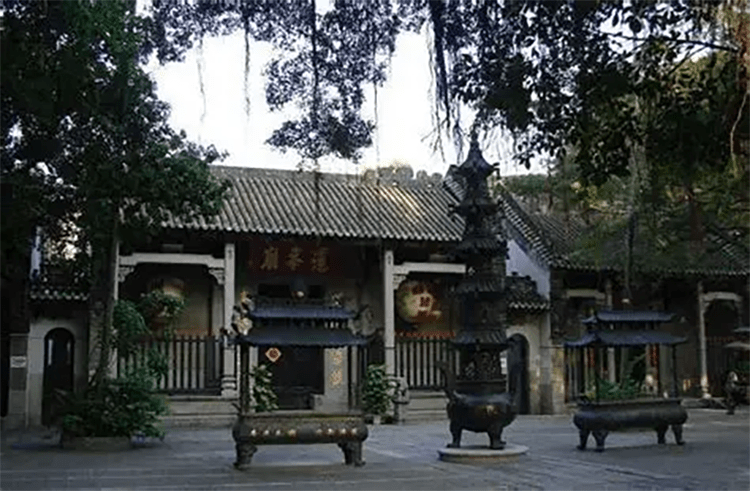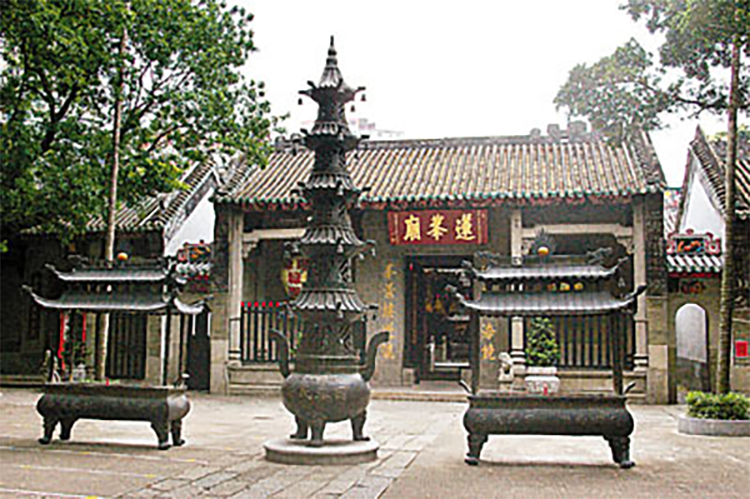Lotus Temple Macau: Visitor Guide to a Living Heritage of Three Faiths
Introduction: Four Centuries of Incense and Stories
At the northern tip of the Macau Peninsula stands a grey-tiled, green-brick temple where incense curls and centuries of stories meet. Lotus Temple, founded in 1592 in the Lingnan style, is one of Macau’s three great historic temples and a rare example of Taoist, Buddhist and Confucian worship sharing a single sacred complex. Its painted carved beams still glow with color, the incense table where Lin Zexu once worked remains on display, and the annual Mazu birthday festival keeps the site a vibrant community hub. For visitors who want to understand Macau’s blended Chinese-Portuguese soul, Lotus Temple is essential.
1. Key Features: A Living Lingnan Monument of Three Faiths
One-line essence: The only site within the Macau Historic Centre UNESCO ensemble that visibly integrates Taoism, Buddhism and Confucianism in one centuries-old temple, interweaving Mazu devotion and diplomatic memory.
Unique selling points:
– Rare three-faith fusion: The main altar honors Tin Hau (Mazu, Taoist), while Guanyin (Buddhist) and Confucius (Confucian) are also enshrined, reflecting Macau’s religious inclusiveness.
– Witness to history: In 1839 Lin Zexu used the temple’s incense table to hold meetings during the anti-opium campaign; related artifacts are exhibited on-site as tangible diplomatic records.
– Open-air Lingnan craft museum: Green bricks, grey tiles, carved wooden beams, colorful grey-plaster figures and painted eaves preserve traditional southern Chinese craftsmanship.
2. History: From a Ming Shrine to World Heritage
– 1592: Lotus Temple was established as a folk shrine to the sea goddess Tin Hau (Mazu), protecting local fishermen.
– Qing heyday: Expanded into a three-courtyard layout with a Guanyin hall and a Wenchang hall, forming the present triadic religious layout.
– 1839: Imperial commissioner Lin Zexu inspected Macau during the opium campaign and met Portuguese officials at the temple; the incense table used then is displayed inside.
– 2005: Listed as part of the UNESCO World Heritage “Historic Centre of Macau.”
Cultural status:
– Religious: A major Tin Hau worship site—every lunar March 23 the Mazu birthday draws devotees citywide.
– Community: Traditional markets and Cantonese opera performances during festivals make the temple a living center for local cultural transmission.

3. Architecture and Art: Decoding Lingnan Temple Symbols
Architecture and symbolism:
– Gate: Built of granite with a calligraphic plaque reading “Lotus Temple” attributed to Qing-era handwriting; flanked by grey-plaster qilin symbolizing good fortune.
– Front hall: Houses Maitreya and the Four Heavenly Kings—Buddhist elements are prominent; look up to see an eight-sided coffered ceiling and intricate woodcarving symbolizing heaven and earth.
– Main hall: Dedicated to Tin Hau, the goddess statue wears a ceremonial crown; attendants Qianliyan and Shunfeng’er stand to her sides. A plaque reading “Sea Keeps Calm” reflects fishermen’s faith.
– Side halls: The left contains a Guanyin shrine; the right houses a Wenchang hall with a Confucius statue and imperial examination relics invoking literary success.
Art highlights:
– Grey-plaster figures: Colorful ridge decorations and birds created with traditional Lingnan techniques remain vivid despite the weather.
– Lin Zexu’s incense table: A redwood table displays reproduction documents and a bilingual Chinese-Portuguese plaque explaining the historical context.
4. Immersive Experience: How to Worship Like a Local
Religious activities and how to participate:
– Daily rites: Devotees burn incense at dawn and monks chant sutras; visitors may offer a voluntary donation (recommended MOP 5–10).
– Mazu birthday: On lunar March 23 a stage is erected for deity operas and the Tin Hau statue is paraded—reserve your viewing spot early.
– Incense etiquette: Buy incense at the entrance (about MOP 10 per bundle), hold sticks with both hands, raise them to your forehead, and place them in the censer in the order middle → right → left.
Do’s and don’ts:
– Ask permission or aver a polite “excuse me” before photographing deities; avoid direct frontal shots of statues and never touch artifacts.
– Speak softly inside halls and move clockwise when circling altars.

5. Atmosphere: A Quiet Sanctuary in the Bustle
Who you’ll see:
Mornings attract older worshippers, afternoons draw cultural tourists; weekday visits are quieter than weekends.
Mood:
A blend of bustling incense and solemn historical weight.
Setting:
Ancient trees shade the forecourt; the temple sits a single wall away from lively Macau streets, creating a striking contrast between sacred solitude and urban life.
6. Practical Visit Tips and Suggested Itineraries
– Suggested time: 1.5 hours for a focused visit including artifact viewing and photography.
– Best times: 9–11 a.m. for ideal lighting on carvings, or late afternoon for chanting.
– Pairing suggestions:
– Half-day culture route: Lotus Temple → Lin Zexu Memorial (5-minute walk) → Macau Tea Culture House (try Portuguese-influenced milk tea).
– Full-day heritage loop: Lotus Temple → Ruins of St. Paul’s → St. Dominic’s Church → Mount Fortress and the Theatre.

7. Visitor Information and Local Tips
– Opening hours: 08:00–18:00. Free admission; no reservation required.
– Getting there:
– Bus: Routes 1, 3, 10 stop at “Lotus Temple” station.
– Walk: About 15 minutes from Portas do Cerco Plaza toward Iao Hon New Village.
– Language: Signs are in Chinese, Portuguese and English; most exhibit labels are in Chinese.
– Facilities: Free drinking water near the temple side; no vegetarian canteen on site. Nearby tea restaurants are plentiful—try “Feng Cheng Zhu Ji” wonton noodles.
Local advice:
– The Mazu festival draws crowds but offers the most authentic atmosphere; visit a week before or after the date for fewer people.
– Beware of fortune-tellers outside the temple—official blessings are organized by the temple itself.
Conclusion: A Microcosm of Macau’s Multicultural Soul
Lotus Temple reads like a three-dimensional history book: fishermen’s prayers etched in green brick, Lin Zexu’s resolute legacy stationed at an incense table, and the exceptional sight of three religions sharing one roof—all emblematic of Macau’s harmonious diversity. Before you leave, consider buying a bundle of temple incense; the trailing smoke makes for a poetic farewell.
Practical facts
– Name: Lotus Temple (Lotus Temple Macau)
– Address: Avenida do Conde de São Januário area (near Iao Hon New Village), Macau
– Admission: Free
– Official info: Macau Cultural Affairs Bureau World Heritage pages (virtual tours available)


